- Clone
- TLR-104 (See other available formats)
- Regulatory Status
- RUO
- Other Names
- Toll like receptor 3, TLR-3, CD283
- Isotype
- Mouse IgG2a, κ
- Ave. Rating
- Submit a Review
- Product Citations
- publications
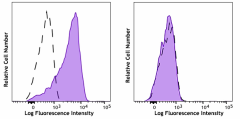
-

Human TLR3 transfected HEK293 cells (left) and parent HEK293 cells (right) were fixed, permeabilized and then stained with CD283 (clone TLR-104) Brilliant Violet 711™ (filled histogram) or Mouse IgG2a, κ Brilliant Violet 711™ (open histogram).
| Cat # | Size | Price | Save |
|---|---|---|---|
| 315007 | 25 tests | ¥47,300 | |
| 315008 | 100 tests | ¥95,700 |
Toll-like receptor 3 (TLR3) is a 104 kD protein also known as CD283. It is expressed selectively on the cytoplasmic membrane and intracellularly in dendritic cells. TLR3 is also highly expressed in the placenta, pancreas, heart, liver, lung, and muscle. TLR3 is a pattern recognition receptor that participates in innate immune response to microbial pathogens. The ligands recognized by TLR3 are polyinosine-polycytidylic acid (Poly(I:C)) and dsRNA. TLR3 ligands induce NF-κB activation (via TRIF-linked RIP1/TLR3 interactions) and cytokine production. TLR3 has been shown to interact with a number of proteins including MYD88, TRAF6, TRIAD3, MAP3K7, and TAB2. This antibody is useful for flow cytometry and Western blotting.
Product DetailsProduct Details
- Verified Reactivity
- Human
- Antibody Type
- Monoclonal
- Host Species
- Mouse
- Immunogen
- Recombinant human Toll-like receptor 3 protein
- Formulation
- Phosphate-buffered solution, pH 7.2, containing 0.09% sodium azide and BSA (origin USA).
- Concentration
- Lot-specific (to obtain lot-specific concentration and expiration, please enter the lot number in our Certificate of Analysis online tool.)
- Storage & Handling
- The antibody solution should be stored undiluted between 2°C and 8°C, and protected from prolonged exposure to light. Do not freeze.
- Application
-
ICFC - Quality tested
- Recommended Usage
-
Each lot of this antibody is quality control tested by intracellular immunofluorescent staining with flow cytometric analysis. For flow cytometric staining, the suggested use of this reagent is 5 µl per million cells in 100 µl staining volume or 5 µl per 100 µl of whole blood.
Brilliant Violet 711™ excites at 405 nm and emits at 711 nm. The bandpass filter 710/50 nm is recommended for detection, although filter optimization may be required depending on other fluorophores used. Be sure to verify that your cytometer configuration and software setup are appropriate for detecting this channel. Refer to your instrument manual or manufacturer for support. Brilliant Violet 711™ is a trademark of Sirigen Group Ltd.
Learn more about Brilliant Violet™.
This product is subject to proprietary rights of Sirigen Inc. and is made and sold under license from Sirigen Inc. The purchase of this product conveys to the buyer a non-transferable right to use the purchased product for research purposes only. This product may not be resold or incorporated in any manner into another product for resale. Any use for therapeutics or diagnostics is strictly prohibited. This product is covered by U.S. Patent(s), pending patent applications and foreign equivalents. - Excitation Laser
-
Violet Laser (405 nm)
- Application Notes
-
Additional reported applications (for the relevant formats) include: Western bloting. The fluorochrome-labeled TLR-104 antibody is useful for intracellular immunofluorescent staining and flow cytometric analysis. For intracellular staining protocol, please visit www.biolegend.com and click on the support tab.
-
Application References
(PubMed link indicates BioLegend citation) - RRID
-
AB_2728265 (BioLegend Cat. No. 315007)
AB_2728265 (BioLegend Cat. No. 315008)
Antigen Details
- Structure
- Toll-like receptor family member, type I membrane protein containing multiple leucine repeats and a interleukin-1 receptor like region in the extracellular domain, predicted molecular weight approximately 104 kD
- Distribution
-
Selective expression in dendritic cells. Highly expressed in placenta, pancreas, also expressed in heart, liver, lung and muscle
- Function
- Pattern recognition receptor that participates in innate immune response to microbial pathogens. TLR3 ligands induce NF-κB (via TRIF-linked RIP1/TLR3 interactions) and cytokine production. TLR3 stimulation results in the production of the cytokines
- Interaction
- MYD88, TRAF6, TRIAD3, MAP3K7, TAB2
- Ligand/Receptor
- Polyinosine-polycytidylic acid (Poly(I:C)), dsRNA
- Cell Type
- Dendritic cells
- Biology Area
- Cell Biology, Immunology, Innate Immunity, Neuroinflammation, Neuroscience, Neuroscience Cell Markers
- Molecular Family
- CD Molecules, Toll Like Receptors
- Antigen References
-
1. Alexopoulou L, et al. 2001. Nature 413:732.
2. Doyle SE, et al. 2002. Immunity 17:251.
3. Meylan E, et al. 2004. Nature Immun. 5:503.
4. Muzio M, et al. 2000. J. Immunol. 164:5998.
5. Rock FL, et al. 1998. Proc. Natl. Acad. Sci. 95:588. - Gene ID
- 7098 View all products for this Gene ID
- UniProt
- View information about CD283 on UniProt.org
Related FAQs
Other Formats
View All CD283 Reagents Request Custom Conjugation| Description | Clone | Applications |
|---|---|---|
| Purified anti-human CD283 (TLR3) | TLR-104 | ICFC,WB |
| Brilliant Violet 711™ anti-human CD283 (TLR3) | TLR-104 | ICFC |
| PE anti-human CD283 (TLR3) | TLR-104 | ICFC |
Customers Also Purchased
Compare Data Across All Formats
This data display is provided for general comparisons between formats.
Your actual data may vary due to variations in samples, target cells, instruments and their settings, staining conditions, and other factors.
If you need assistance with selecting the best format contact our expert technical support team.
-
Purified anti-human CD283 (TLR3)
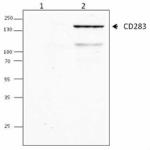
Western blot analysis of extracts from 293T parent (lane 1) ... -
Brilliant Violet 711™ anti-human CD283 (TLR3)

Human TLR3 transfected HEK293 cells (left) and parent HEK293... -
PE anti-human CD283 (TLR3)
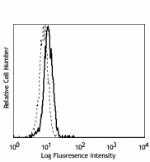
Human TLR3 parental cells intracellularly stained with CD283... 
Human TLR3 transfected cells intracellularly stained with CD...












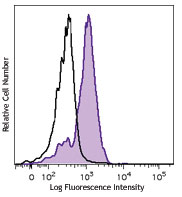
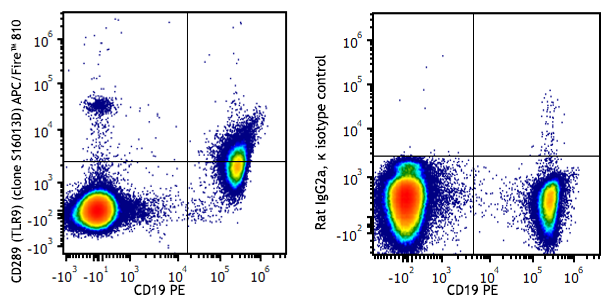
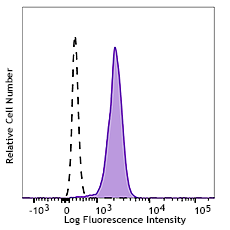
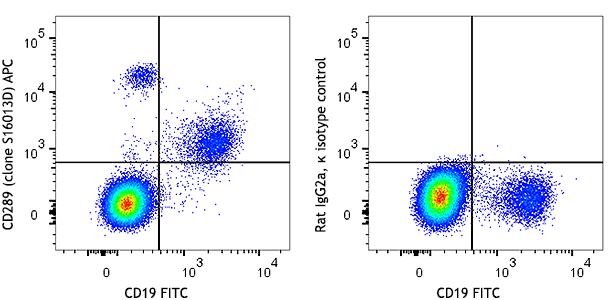



Follow Us